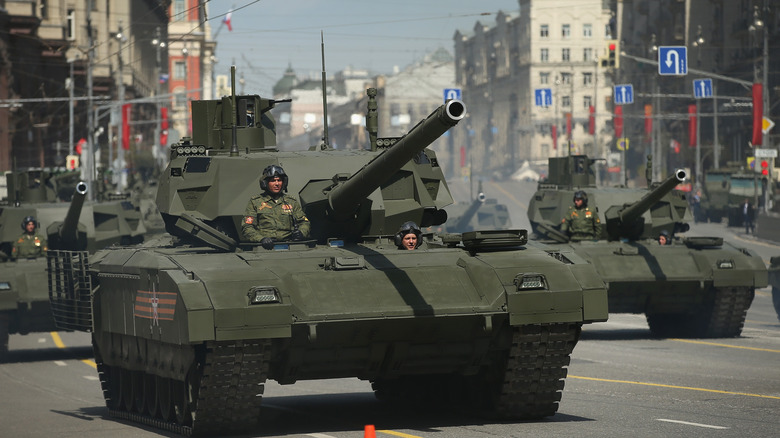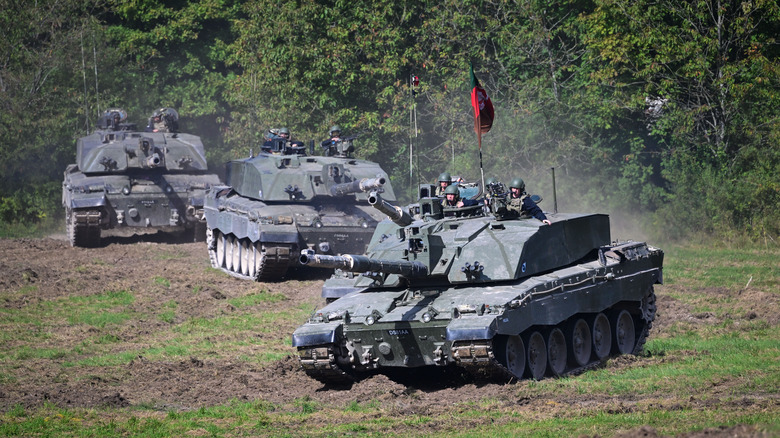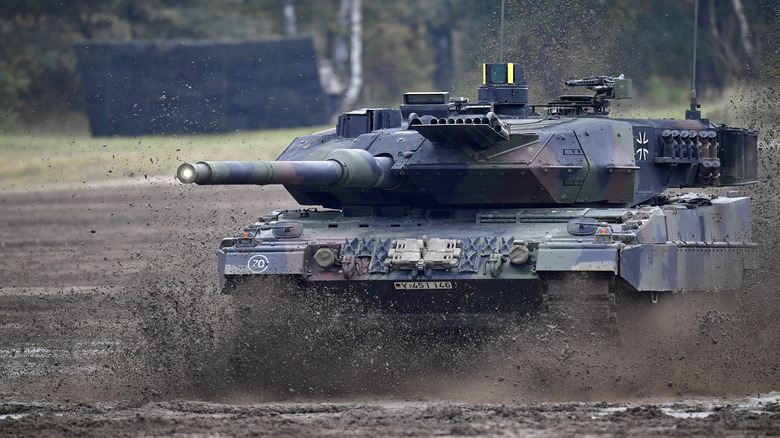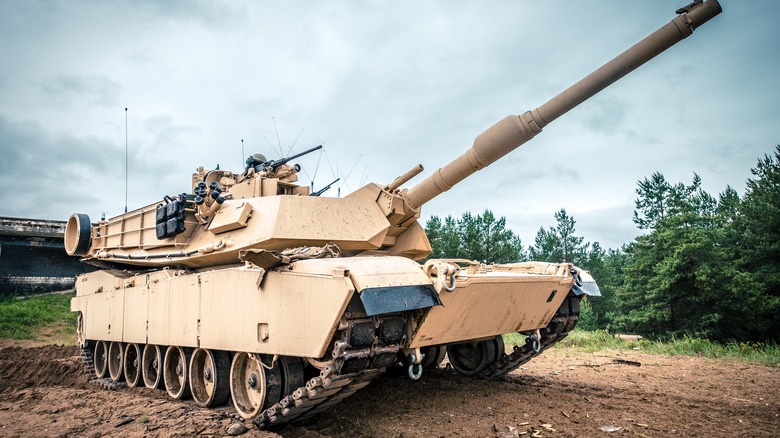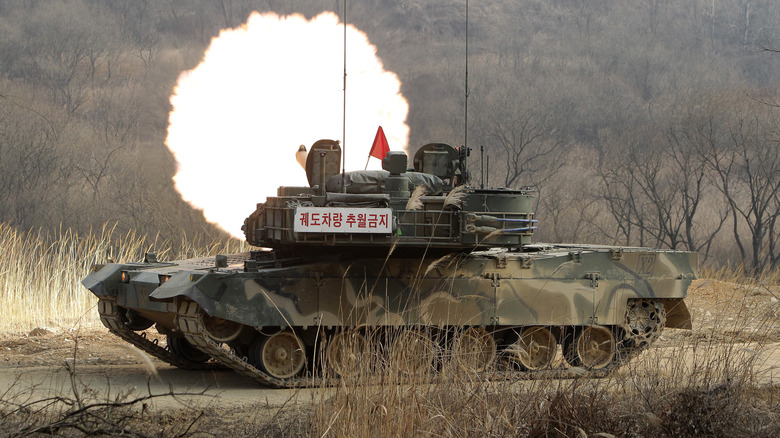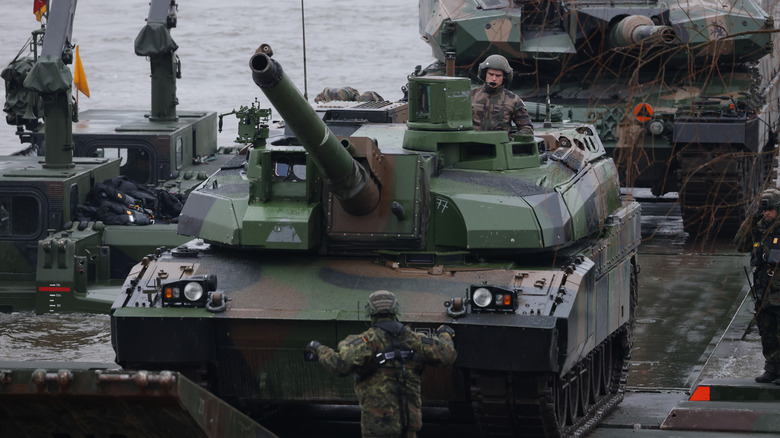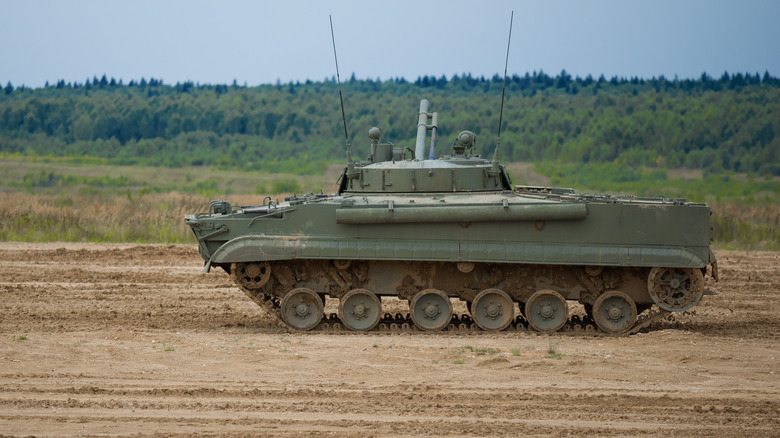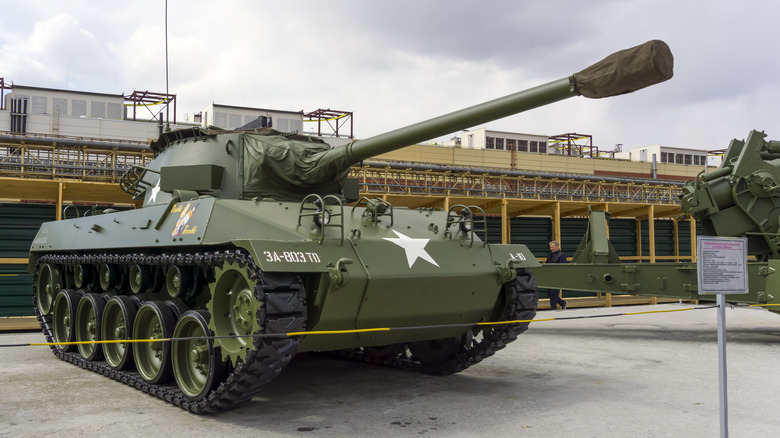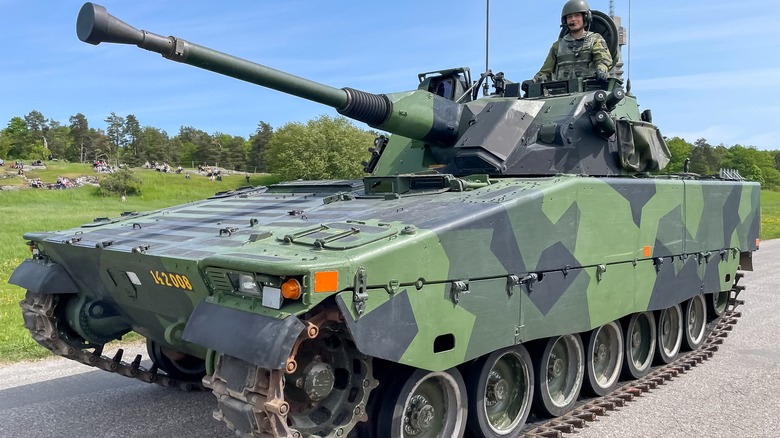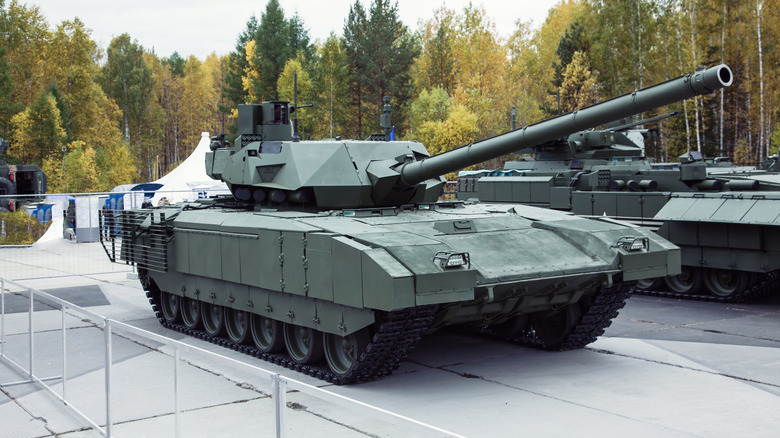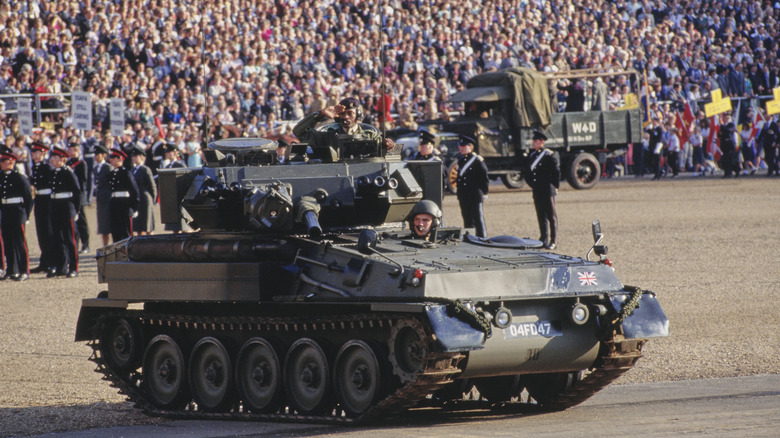10 Of The Fastest Military Tanks Ever Built, Ranked
When you think of a tank, fast probably isn't a descriptor that immediately comes to mind. After all, tanks are heavily armed with large cannons and often feature thick armor to protect them from incoming shells and anti-tank missiles. Utilizing tracks rather than wheels, they are vehicles designed to operate over any terrain, punch through the enemy line, and provide support and cover for infantry troops.
But none of that means that tanks can't also move quickly. Many of the most expensive tanks ever built are main battle tanks, modern armored vehicles that combine the lethality and defensive capabilities of heavy tanks with the agility and manoeuvrability of light tanks. This means that as well as being able to dish out and withstand a lot of damage, they can also reach high speeds.
That's essential in a world where warfare can often be fast paced, requiring armored vehicles to quickly get to their destination to respond to threats and react immediately to enemy movements. Some tanks can travel at well over 40 mph and some can even go faster than that. Let's look at 10 of the fastest, ranked by top speed.
10. Challenger 2 — 37 mph
Germany has the Leopard 2, the U.S. has the M1 Abrams, and the U.K has its own third-generation main battle tank. As the name suggests, the Challenger 2 is a direct evolution of the earlier Challenger 1. Production began on the successor in the early 1990s before the tank went on to enter service in 1998. Since then, it has been involved in a number of combat operations around the world, including the Kosovo War, the Iraq War, and the current war in Ukraine.
More than 400 Challenger 2 tanks have been built and the vast majority are used by the British Army. However, Oman has also ordered a number of the Challenger 2 tanks to use in its own armed forces. Costing a little over $5 million to manufacture, this armored vehicle is relatively cheap compared to many other main battle tanks but that doesn't make it a pushover. In fact, there is plenty that makes the Challenger II special and until it was used by Ukraine, none had ever been destroyed by enemy forces.
Carrying a 120 mm L30 rifled gun, the Challenger II has similar offensive capabilities to its main counterparts. It also features two 7.62 mm machine guns and a distinctive armor known as Dorchester 2 that provides excellent protection from incoming fire. Able to travel a maximum range of 340 miles, the Challenger 2 can reach speeds of 37 mph.
9. Leopard 2A7 — 42 mph
There's a good chance that Western countries that don't use the M1 Abrams will instead have the Leopard 2 serving as the main battle tank of choice. Originated in the 1970s as Europe was still gripped in the Cold War, it was intended to provide West Germany with a powerful and effective tank to outclass the vast armored divisions of East Germany and the Soviet Union. The end result was a tank that has been exported to dozens of countries around the world and is an ever-present part of European armies.
Costing upward of $30 million for the most recent Leopard 2A8 variant, this main battle tank is among the most costly in the world. For that money, the vehicle comes with a 120 mm main cannon that has a unique stabilization system allowing the tank to fire on enemy targets without slowing down or stopping. Two 7.62 mm machine guns give it extra firepower at close range and the tank also boasts several digital systems to aid in targeting enemies and providing active protection systems.
Pushing the tracked behemoth along is a 1,500 horsepower MTU V12 twin-turbo engine, which is liquid cooled to provide peak performance. This allows the large tank to reach speeds of 42 mph on level terrain and last for an operational range of at least 170 miles.
8. M1 Abrams — 42 mph
The M1 Abrams has been the backbone of the U.S. Army for decades. First introduced more than 40 years ago, it is widely regarded as one of the most successful and best main battle tanks of modern times. Anywhere that the United States and its allies have been stationed, the M1 Abrams is likely to have accompanied them. As it has been around so long, the tank has gone through numerous revisions, with the M1A2 SEP Abrams being the current standard since its introduction in 1992.
This model of the tank features a number of updates, ranging from an upgraded Trophy Active Protection system, stronger graphite coated armor, and a digital battlefield management system. The M1 Abrams comes equipped with a powerful 120mm smoothbore cannon and has a 50 caliber heavy machine gun and two 7.62 mm machine guns for close support. Exported to dozens of countries around the world, it can cost up to $19 million per unit.
A Honeywell AGT1500 multi-fuel turbine engine is responsible for moving the tank, which can weigh anywhere between 60 and 70 tons depending on the exact specification. Capable of generating up to 1,500 horsepower, this allows the M1 Abrams to travel at a top speed of 42 mph on even surfaces, while it moves slower on rough terrain.
7. K2 Black Panther — 43 mph
One of the most modern main battle tanks currently in service, the K2 Black Panther is South Korea's answer to the likes of the M1 Abrams, the Leopard 2, and the Challenger 2. Entering service in 2014, the tank was in development for more than a decade before it entered production with Hyundai Rotem. Intended to be able to respond to rapidly emerging threats in case of a conflict with North Korea, the K2 Black Panther integrates a number of network-oriented systems to quickly share information across a wide range of units.
This includes the KSTAM-II system, which helps the tank automatically target enemy forces at a range in excess of five miles, alongside a C4I uplink and a Battle Management System. Working in tandem with the autoloading 120 mm L/55 smoothbore gun, this is a tank that can deliver a lethal payload and connect with other units. These features have made the K2 Black Panther one of the most expensive tanks ever made, costing the South Korean government $8.5 million per tank.
A Tognum MT 833 diesel engine capable of producing up to 1,500 horsepower provides the power for the 60 ton tank. Combined with the hydropneumatic suspension, it can reach a top speed of 43 mph on the road and on uneven terrain is capable of moving at in excess of 30 mph.
6. AMX–56 Leclerc — 45 mph
The AMX-56 Leclerc is a French-made main battle tank. It is somewhat aged compared to many other modern tanks but has remained an integral part of the French military and been involved in operations around the world, including peacekeeping missions in Kosovo and Lebanon, as well as the Yemeni Civil War as part of Saudi Arabia's coalition against the Houthis. Around 800 tanks under the AMX-56 designation have been produced since the tank first entered service in 1992, although France now intends to replace this model with the more recent Leclerc XLR.
This tank is armed with a 120 mm version F1 smoothbore gun, which features an autoloading system. This means the weapon can be fired at a much faster rate when compared to manually loaded weapons and also requires less crew to operate. In fact, only three people are needed to operate the tank. Compatible with standard NATO shells, it can fire up to nine times in a minute, allowing the AMX-56 to dish out a lot of damage in a short amount of time.
Designers intended the AMX-56 to avoid enemy fire when possible, utilizing a philosophy of high mobility and force in exchange for less defensive capabilities. With lighter armor than many other modern main battle tanks, the French vehicle is nimble and can travel at 45 mph on the road. When speed doesn't allow the tank to escape, Nexter Systems' active protection system can help to prevent enemy fire from reaching it.
5. BMP-3 — 45 mph
As you might have guessed from its name, the BMP-3 is the third incarnation of the Russian BMP tank. Technically designated as an infantry fighting vehicle, the BMP-3 closely resembles standard main battle tanks. It was developed during the late 1970s and entered service during the 1980s, with thousands of the armored vehicle — and its range of variants — being manufactured by Kurganmashzavod.
Among the most heavily armed infantry combat vehicles in the world, the BMP-3 features a 100 mm gun-launcher 2A70, a rifled cannon that can launch high-explosive frag rounds in addition to anti-tank missiles. This makes it highly effective at fighting soldiers on the ground and other armored vehicles. It also comes equipped with a 30 mm 2A72 autocannon, a grenade launcher, and up to three 7.62 mm machine guns.
Still in high demand because of its versatility and mobility, the BMP-3 can carry up to seven troops, is operated by a crew of three, and weighs less than 20 tons. Powered by a 500 horsepower UTD-29M diesel, it can travel at a maximum speed of 45 mph, although this is lowered significantly when off road. Additionally, the BMP-3 is capable of moving through water at a speed of 6.2 mph thanks to water jets that power it when the vehicle is submerged.
4. M18 Hellcat — 50 mph
The M18 Hellcat is a vintage tank destroyer first used by the United States in the Second World War. Since that time, it has seen combat in the Korean War and — following export to a number of European countries — has also been involved in the Yugoslav Wars and other conflicts. From the outset, the vehicle was designed to be faster and more mobile than a traditional tank, able to quickly get into position and strike targets with its powerful main weapon before moving on.
Despite having very little in the way of armor, the Hellcat still weighed more than 17 tons. This was largely due to the large M1 76 mm main gun and the fact that it held a crew of five people. It also had to be sturdy enough to be able to travel across difficult terrain and ram through structures without incurring serious damage.
Off road, the Hellcat was only capable of reaching a top speed of around 26 mph but on a flat road surface, it could go significantly faster. Some reports suggest it could go as fast as 55 mph, although reliable sources indicate it had a top speed of around 50 mph. That's still fast enough to make the M18 one of the fastest tanks to ever enter active service. Power came from a Wright R-975 nine-cylinder aircraft engine.
3. CV90 Armadillo — 50 mph
Designated as the Combat Vehicle 90, but known by the shorter and snappier CV90, this is a Swedish tank as a joint collaboration between the Swedish Defence Materiel Administration, Hägglund, BAE Systems AB, and Bofors. Development began on the armored vehicle in the 1980s before it entered service in 1994 and it has since been exported to several European countries, including Denmark, Finland, and the Netherlands. Some 1,400 have now been built and there are a large number of variants available.
After the Cold War came to an end, Sweden recognized that it needed tanks and other tracked armored vehicles that could travel large distances at high speed. This was especially important given the country's proximity to Russia. After extensive testing, the CV90 was chosen as it would be able to travel across the Nordic environment, perform a variety of battlefield functions, and outmaneuver similar tanks fielded against it.
The latest version of the tank, dubbed the Armadillo, is powered by a DC16 16-liter diesel V8 engine capable of producing in excess of 800 horsepower, This drives the 30 ton vehicle at speeds of up to 50 mph. An active suspension system even means it can reach impressive speeds over rough terrain and carry a 40 mm Bofors L/70 autocannon as well as a machine gun and grenade launchers. This makes it a formidable force against infantry and airborne targets.
2. T-14 Armata — 50 mph
It isn't unusual for modern main battle tanks to exceed 40 mph but very few have ever broken the 50 mph barrier. According to reports, the Russian-made T-14 Armata may well be part of that select club. The T-14 Armata is Russia's next-generation battle tank, intended to replace the vast amount of the outdated Soviet-era tanks that make up the bulk of Russia's armored divisions.
At 55 tons, getting this tank up to 50 mph is no easy task. An A-85-3A turbocharged diesel engine provides the powertrain for the tank and is powerful enough to keep the T-14 running for up to 300 miles before refueling and servicing. Based on the Armata Universal Combat Platform, it entered early development in 2014 and full production began in 2021, although limited numbers have entered active service.
Sitting atop the tank is a 152 mm main gun capable of firing a special kind of armor-piercing fin-stabilized discarding sabot (APFSDS) shell known as the Vacuum-1. A 12.7 mm machine gun and a 7.62 mm machine gun make up the secondary weapons, while steel and composite armor protect it from incoming fire.
1. FV101 Scorpion — 51 mph
Among all of the tanks that have ever been created, the FV101 Scorpion stands out as the undisputed king of speed. The British reconnaissance vehicle holds the record for being the fastest tank on the planet, capable of reaching a top speed of 51 mph according to Guinness World Records. This means it can outpace any other tank in the world and is significantly faster than any main battle tank or other large armored vehicle in use today,
Considering that the FV101 first entered service in 1973, saw production end in 1994, and has largely been retired from service since the late 1990s, it might be something of a surprise to discover that it still holds the speed record. But that speed came from a specific requirement for the U.K. military to have a light tank capable of being delivered to locations via airborne transport — particularly important for the country, given that it's an island.
Built by Alvis Vehicles, the FV101 came equipped with a 76mm L23A1 gun and a 7.62 mm coaxial machine gun, with the vehicle being powered by a 190 horsepower 5.9 liter engine. Thanks to its operation range of 470 miles, it had the ability to quickly cover a large amount of ground and the tank saw action in the Falklands war and the Gulf war.
